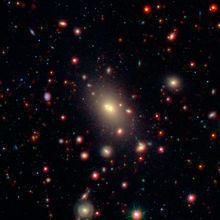Right ascension 16 28 38.276 Helio radial velocity −9100 km/s Apparent magnitude (V) 12.78 | Declination +39° 33′ 04.97″ Distance 490 Mly(142 mpc) Magnitude 11.78 | |
 | ||
Redshift z = −0.030354(minus signindicates blueshift) Similar Abell 2199, NGC 6085, NGC 6181, NGC 6200, NGC 6027 | ||
NGC 6166 is an elliptical galaxy in the Abell 2199 cluster. It lies 490 million light years away in the constellation Hercules. The primary galaxy in the cluster, it is one of the most luminous galaxies known in terms of X-ray emissions.
Description
NGC 6166 is a supermassive, type cD galaxy, with several smaller galaxies within its envelope.
Suspected to have formed through a number of galaxy collisions, NGC 6166 has a large number of globular clusters (estimated as between 6,200 and 22,000 in 1996) orbiting the galaxy. A 2016 study, however, gave an even higher number (around 39,000) suggesting also that the halo of this galaxy blends smoothly with the intra-cluster medium
The galaxy harbors a supermassive black hole at its center with a mass of nearly 30 billion
NGC 6166 is known to host an active nucleus, classified as an FR I source, which powers two symmetric parsec-scale radio jets and radio lobes and it is caused by the infall of gas into its center caused by a cooling flow that deposits 200 solar masses of gas every year there.
It has been proposed that a number of O-type stars may be present in the center of NGC 6166
